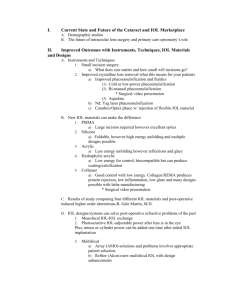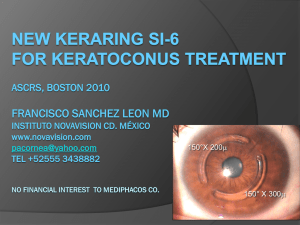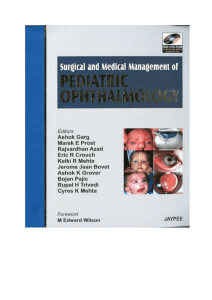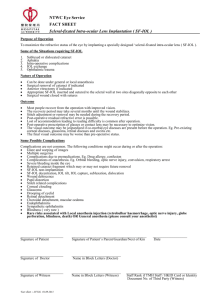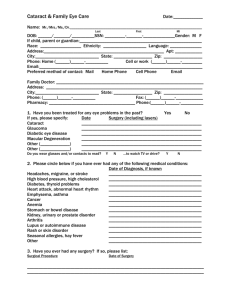Drug Prescribing Patterns in Intra-Ocular Lens Implantation
advertisement
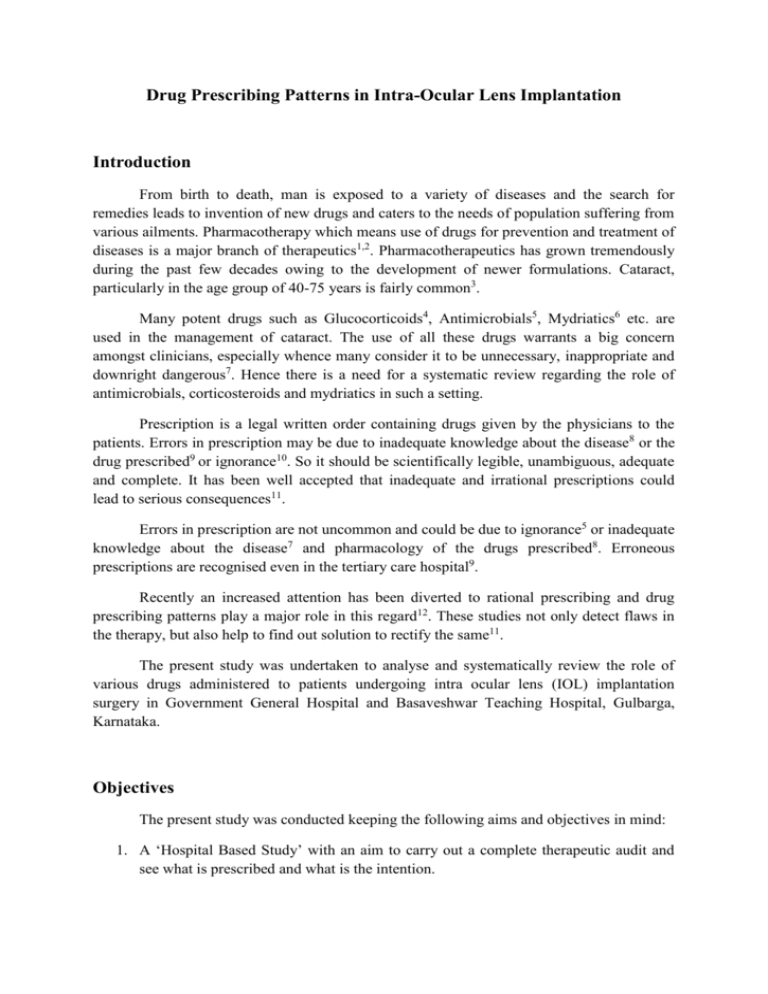
Drug Prescribing Patterns in Intra-Ocular Lens Implantation Introduction From birth to death, man is exposed to a variety of diseases and the search for remedies leads to invention of new drugs and caters to the needs of population suffering from various ailments. Pharmacotherapy which means use of drugs for prevention and treatment of diseases is a major branch of therapeutics1,2. Pharmacotherapeutics has grown tremendously during the past few decades owing to the development of newer formulations. Cataract, particularly in the age group of 40-75 years is fairly common3. Many potent drugs such as Glucocorticoids4, Antimicrobials5, Mydriatics6 etc. are used in the management of cataract. The use of all these drugs warrants a big concern amongst clinicians, especially whence many consider it to be unnecessary, inappropriate and downright dangerous7. Hence there is a need for a systematic review regarding the role of antimicrobials, corticosteroids and mydriatics in such a setting. Prescription is a legal written order containing drugs given by the physicians to the patients. Errors in prescription may be due to inadequate knowledge about the disease8 or the drug prescribed9 or ignorance10. So it should be scientifically legible, unambiguous, adequate and complete. It has been well accepted that inadequate and irrational prescriptions could lead to serious consequences11. Errors in prescription are not uncommon and could be due to ignorance5 or inadequate knowledge about the disease7 and pharmacology of the drugs prescribed8. Erroneous prescriptions are recognised even in the tertiary care hospital9. Recently an increased attention has been diverted to rational prescribing and drug prescribing patterns play a major role in this regard12. These studies not only detect flaws in the therapy, but also help to find out solution to rectify the same11. The present study was undertaken to analyse and systematically review the role of various drugs administered to patients undergoing intra ocular lens (IOL) implantation surgery in Government General Hospital and Basaveshwar Teaching Hospital, Gulbarga, Karnataka. Objectives The present study was conducted keeping the following aims and objectives in mind: 1. A ‘Hospital Based Study’ with an aim to carry out a complete therapeutic audit and see what is prescribed and what is the intention. 2. To study and evaluate the role of corticosteroids, antimicrobials and mydriatics during IOL implantation. 3. To suggest measures to rationalise the therapeutic regimen. Materials and Methods Two teaching hospitals attached to MR Medical College were selected for this study, namely Governement General Hospital and HKES Basaveshwar Teaching Hospital representing both the upper and lower economic strata of the population. The study was carried out from 01-08-2012 to 30-04-2013 after due permission from the Institutional Ethics Committee, Head of Department of Ophthalmology, Basaveshwar Teaching Hospital and the Dean, MR Medical College. A Proforma and an Informed Consent form were provided to all the participating doctors. All the prescriptions were analysed and classified according to the drug employed and its route of administration. The present study included all patients who were admitted for IOL implantation surgery between 40 and 75 years of age of either sex. Patients were selected randomly and detailed history was elicited from all. Patients with multiple, concomitant illnesses such as diabetes mellitus, hypertension, tuberculosis etc. were excluded from the study. A total of 104 prescriptions were collected, analysed and classified. The prescriptions were collected daily, right from the day of admission till the time of discharge of the patient. Data Analysis The data obtained from the analysis of 104 prescriptions was further condensed and a master chart was prepared using MS-Excel. The data was subjected to statistical analysis. The overall information generated was presented under the following headings: 1. 2. 3. 4. 5. 6. 7. 8. Age wise distribution of cataract in patients undergoing IOL implantation surgery. Sex wise distribution of cataract in patients undergoing IOL implantation surgery. Distribution of patients according to the type of cataract involved. List of all drugs employed in patients undergoing IOL implantation surgery. Average number of drugs used in IOL implantation surgery. Pre-operative drugs employed in patients undergoing IOL implantation surgery. Intra-operative drugs employed in patients undergoing IOL implantation surgery. Post-operative antimicrobial agents employed in patients undergoing IOL implantation surgery. 9. Comparison of prescribed dose with established standard dose. Results About 104 prescriptions were included in the study and analysed after matching the inclusion and exclusion criteria as mentioned earlier from 01-08-2012 to 30-04-2013 from Government General Hospital and Basaveshwar Teaching and General Hospital. Out of the 104 prescriptions studied: 1. Maximum number of patients were encountered in the age group of 51-60 years. 2. 48.07% were male and 51.92% were females 3. A whopping 91.35% of cases for IOL implantation were having mature senile cataract. 4. Pre-operative medications included drugs such as Acetazolamide, Ciprofloxacin, Cotrimoxazole, Prednisolone, Moxifloxacin and Gentamicin. 5. Intra-operative medications included drugs such as sub-conjunctival Dexamethasone and Gentamicin. 6. Post-operative medications employed included drugs such as Acetazolamide, Ampicillin, Chloramphenicol, Ciprofloxacin, Cotrimoxazole, Prednisolone, oxifloxacin, Gentamicin, Tobramycin, Ofloxacin and Gatifloxacin. 7. Our comparison stated that Moxifloxacin is the most frequently prescribed antimicrobial pre-operatively for IOL implantation. Oral Acetazolamide was prescribed as a mydriatic in all the cases, 94% of the cases were prescribed Homatropine eye drops as a mydriatic agent. 8. Also, Moxifloxacin is the most frequently prescribed anti-microbial post-operatively for IOL implantation. Oral Ciprofloxacin was prescribed to nearly 8% of the patients. Dexamethasone (0.1%) was the preferred glucocorticoid and was employed as an anti-inflammatory agent in nearly 77% of the cases. The other topical steroid used was Betamethasone (0.1%), which was used in 21% of the patients. Use of parenteral Dexamethasone was limited to just 3 patients. 9. Overall Moxifloxacin is currently the most frequently prescribed anti-microbial for both pre and post-operative use in IOL implantation surgery. Oral Acetazolamide and topical Homatropine are the most frequently prescribed mydriatic agents used preoperatively for IOL implantation surgery. Dexamethasone (0.1%) eye drops were the most frequently utilised corticosteroids to prevent and treat post-operative inflammation. Table-1 Age wise distribution of cataract in patients undergoing IOL implantation surgery Age in Years Number of Patients Percentage according to age 41 – 50 51 – 60 61 – 70 71 – 80 25 36 31 12 24.03 34.61 29.80 11.53 Chart-1 Percentage 11% 24% 41 - 50 30% 51 - 60 61 - 70 35% 71 - 80 Table-2 Sex wise distribution of cataract in patients undergoing IOL implantation surgery Sex Male Female Number of Patients 50 54 Percentage according to sex 48.08 51.92 Chart-2 Sex wise Distribution (in %) Male Female 48% 52% Table-3 Distribution of patients according to the type of cataract involved Indication Number of Patients Senile mature cataract Developmental cataract Complicated cataract Traumatic cataract Aphakia 95 4 2 2 1 Chart-3 Percentage of types of cataract 91.35 3.85 1.92 1.92 0.96 Type of Cataract 100 90 80 70 60 50 40 30 20 10 0 Table-4 List of all drugs employed in patients undergoing IOL implantation surgery Oral Parenteral Eye Drops Acetazolamide Ampicillin Chloramphenicol Ciprofloxacin Cotrimoxazole Prednisolone Dexamethasone Gentamicin Betamethasone (0.1%) Chloramphenicol (0.5%) Ciprofloxacin (0.3%) Cyclopentolate (0.5-2%) Dexamethasone (0.1%) Gentamicin (0.3%) Homatropine (2.5%) Timolol (0.25% - 0.5%) Lomifloxacin (0.3%) Neomycin (0.5%) Pilocarpine (0.25%) Polymixin B (1%) Moxifloxacin 0.5% Tobramycin 0.3% Ofloxacin 0.3% Gatifloxacin 0.3% Table-5 Average number of drugs used in IOL implantation surgery Number of Drugs Number of Patients Percentage 5-8 8-10 > 10 12 74 18 11.50 71.15 17.30 Chart-5 Number of Drugs 80 70 60 50 Number of Drugs 40 30 20 10 0 5-8 8-10 > 10 Table-6 Pre-operative drugs employed in patients undergoing IOL implantation surgery Oral Drugs Number of Patients Percentage Acetazolamide Ciprofloxacin Cotrimoxazole Prednisolone Eye Drops 104 12 3 1 Number of Patients 100 11.5 2.88 0.96 Percentage Moxifloxacin (0.5%) Gentamicin (0.3%) Ciprofloxacin (0.3%) Homatropine (2.5%) Timolol (0.25-0.5%) 70 28 6 98 2 67.30 26.92 5.78 94.23 1.92 Table-7 Intra-operative drugs employed in patients undergoing IOL implantation surgery Drugs Number of Patients Percentage Sub-conjunctival Dexamethasone (0.5ml) Sub-conjunctival Gentamicin (0.5ml) 104 100 104 100 Table-8 Post-operative drugs employed in patients undergoing IOL implantation surgery Oral Drugs Number of Patients Percentage Acetazolamide Ampicillin Chloramphenicol Ciprofloxacin Cotrimoxazole Prednisolone Parenteral Drugs 9 3 2 8 15 6 Number of Patients 8.65 2.88 1.92 7.69 14.42 5.76 Percentage Dexamethasone Eye Drops 3 Number of Patients 2.88 Percentage Betamethasone (0.1%) Chloramphenicol (0.5%) Ciprofloxacin (0.3%) Cyclopentolate (0.5-2%) Dexamethasone (0.1%) Gentamicin (0.3%) Homatropine (2.5%) Lomifloxacin (0.3%) Neomycin (0.5%) Pilocarpine (0.25%) Polymixin B (1%) Timolol (0.25-0.5%) Moxifloxacin (0.5%) Tobramycin (0.3%) Ofloxacin (0.3%) Gatifloxacin (0.3%) 22 50 8 3 80 4 2 2 22 1 4 2 72 12 6 2 21.15 48.07 7.69 2.88 76.92 3.80 1.92 1.92 21.15 0.96 3.84 1.92 69.23 11.53 5.76 1.92 Discussion Cataract is a leading cause of blindness worldwide, and India alone has an estimated 8 million people who are blind due to cataract with an annual increase upto 3 million. Surgical Intraocular Lens implantation is the best treatment option currently available13. The aim of the study was to throw light on the aspects like surgeons’ preference for a particular drug, the drug utilization pattern, a comparison between the standard dose and the prescribed dose, to find out irrationality amongst the prescriptions and to suggest methods for rationalisation of existing therapeutic modalities. Currently, we are blessed with a whole range of drugs which are used as adjuncts in IOL implantation surgery. There are various routes of administration available for these drugs and the best possible route with the maximum efficacy and the minimum adverse effects must be selected for treatment. Amongst the available preparations of a drug, the clinician should discern whether to use oral, parenteral or topical drug form. The study was done over a period of 8 months, from 01-08-2012 to 30-04-2013 involving a total of 104 patients posted for IOL implantation. All patients in our study were discharged the same day of surgery and no hospital stay was required. The selection of a particular anti-microbial in the clinical practice of Ophthalmology is difficult because of the advent of newer and safer drugs like Moxifloxacin, Tobramycin and Gatifloxacin over the recent past14. The results of our study indicated that the maximum number of patients were encountered in the age group of 51-60 years amounting to approximately 34% of the total study population (Table 1). Cataract is a fairly common ailment in the elderly and 75% of our study population was above 50 years of age. Sex of the patient did not play a vital role and almost all the cases were equally divided amongst both the sexes (Table 2). Maximum indication for IOL implantation surgery in the present study was for senile mature cataract. A whopping 91.35% of cases for IOL implantation were having mature senile cataract, whereas 3.85% patients had developmental cataract, 1.92% had traumatic cataract and 0.96% suffered from aphakia (Table 3). This reiterates that senile mature cataract is currently the most common indication for IOL implantation surgery. In a clear majority of patients amounting to 72%, 8-10 drugs were employed during pre-, intra- and post-operative phases of IOL implantation surgery (Table 5). Our present study found out that all 104 patients studied were prescribed topical antimicrobials. These were employed both pre and post-operatively. Pre-operative (prophylactic) antimicrobials employed included drugs such as Moxifloxacin, Gentamicin and Ciprofloxacin. Amongst them, Moxifloxacin 0.5%, was employed in 67.3% of the cases making it the overwhelmingly favourite choice of the clinicians currently (Table 6). Older drugs like Gentamicin 0.3% has been losing favour amongst clinicians owing to its side effect profile and was prescribed only in 26.92% of the cases. Oral Acetazolamide was prescribed as a mydriatic in all the cases, 94% of the cases were prescribed Homatropine eye drops as a mydriatic agent. Post-operative antimicrobials employed included drugs such as Moxifloxacin, Gentamicin, Ciprofloxacin, Tobramycin, Ofloxacin and Gatifloxacin. Here too, Moxifloxacin 0.5% was the overwhelmingly favoured drug, garnering a share of 69.23%. Tobramycin 0.3% was the next most favoured anti-microbial agent and was prescribed in approximately 11% of the study population (Table 7). Dexamethasone (0.1%) was the preferred glucocorticoid and was employed as an anti-inflammatory agent in nearly 77% of the cases. The other topical steroid used was Betamethasone (0.1%), which was used in 21% of the patients. Use of parenteral Dexamethasone was limited to just 3 patients owing to the extensive side effect profile of parenteral corticosteroids15. In the present study, a few prescriptions were found to be irrational. The WHO draft of 1983 describes the criteria for irrational drug prescription as, the medication prescribed is incorrect, unnecessary, inadequate, inappropriate or excessive16. Anti-microbial prescriptions were rational in case of pre-operative use of these drugs. The problem arose in a few cases in the daily dosing schedule of Tobramycin 0.3%, Ofloxacin 0.3% and Gatifloxacin 0.3% when used in the post-operative setting. Two cases out of twelve who were administered Tobramycin and one out of six administered Ofloxacin were using the drug twice a day instead of the standard regimen of six hourly administration17. One person was incorrectly administered Gatifloxacin three times a day against the standard regimen of six hourly dosing18. The administration of topical steroids was also found to be faulty. Both Dexamethasone (0.1%) and Betamethasone (0.1%) were administered in excess to almost all the patients. This reflects a lack in knowledge of proper prescribing of corticosteroids by the clinicians. The typical prescription of Dexamethasone for ophthalmic use is 0.1% eye drops every 4 hours while awake and 0.05% ointment at bedtime for 1 week. The prescribing trend which we observed showed a QID use of only 0.1% Dexamethasone and that too for a duration of 10-14 days. A similar excess was noted in the dosing duration and schedule of Betamethasone 0.1%. Conclusion Our study found that Moxifloxacin is the most frequently prescribed anti-microbial pre-operatively for IOL implantation. Also, Moxifloxacin is the most frequently prescribed anti-microbial post-operatively for IOL implantation. Overall Moxifloxacin is currently the most frequently prescribed anti-microbial for both pre and post-operative use in IOL implantation surgery. Amongst the other drugs, Dexamethasone 0.1% eye drops as an antiinflammatory drug and oral Acetazolamide and Timolol eye drops as mydriatic agents, are frequently employed as per our study report Irrational prescriptions are harmful because they lead to a number of problems such as increased cost of the therapy, therapeutic failure, adverse drug reactions, dangerous drug-drug interactions etc. One way of promoting rational prescribing is by conducting drug utilisation studies, educating and training the doctors adequately regarding the need for rational prescribing. References 1. DiPiro, Joseph T, Talbert RL et al. Pharmacotherapy: a pathophysiologic approach. New York, NY: McGraw-Hill, 2005. 2. Peuskens J. The evolving definition of treatment resistance. Journal of Clinical Psychiatry, 1999. 3. Klein BE, Klein R, Lee KE. Incidence of age-related cataract: the Beaver Dam Eye Study. Archives of Ophthalmology; 1998: 116 (2), 219. 4. Shah GK., Stein JD, Sharma S et al. Visual outcomes following the use of intravitreal steroids in the treatment of postoperative endophthalmitis. Ophthalmology 107, no. 3; 2000: 486-489. 5. Seppälä H, Mohammad AJ, Järvinen H et al. Effect of prophylactic antibiotics on antimicrobial resistance of viridans streptococci in the normal flora of cataract surgery. 6. Nikeghbali A, Falavarjani KG, Kheirkhah A et al. Pupil dilation with intracameral lidocaine during phacoemulsification. Journal of Cataract & Refractive Surgery 2007; 33(1): 101-103. 7. Shiva F, Eidikhani A L, Padyab M. Prescription practices in acute pediatric infections. Journal of Pediatric Infectious Diseases; 2006: 1 (1), 25-28. 8. Aronson JK. Medication errors: what they are, how they happen, and how to avoid them. QJM; 2009: 102(8), 513-521. 9. McDowell SE, Ferner HS, Ferner RE. The pathophysiology of medication errors: how and where they arise. British Journal of Clinical Pharmacology; 2009: 67, no. 6: 605613. 10. Tully MP, Ashcroft DM, Dornan T et al. The causes of and factors associated with prescribing errors in hospital inpatients. Drug Safety; 2009: 32(10), 819-836. 11. Mahar, Michael L. Prescription order packaging system and method. U.S. Patent 6,769,228, issued August 3, 2004. 12. Hogerzeil HV. Promoting rational prescribing: an international perspective. British journal of clinical pharmacology 1995; 39(1): 1-6. 13. Javitt JC, Steinert RF. Cataract extraction with multifocal intraocular lens implantation: a multinational clinical trial evaluating clinical, functional, and qualityof-life outcomes. Ophthalmology 2000; 107(11): 2040-2048. 14. Liesegang TJ. Use of antimicrobials to prevent postoperative infection in patients with cataracts. Current opinion in Ophthalmology 12, no. 1; 2001: 68-74. 15. Kuipers, H. Anabolic steroids: side effects. Encyclopedia of sports medicine and science. Internet Society for Sport Science 1998. 16. De Vries CS, ThFJ de T, Blijleven W. Prescription data as a tool in pharmacotherapy audit (I) general considerations. Pharmacy World and Science 21, no. 2; 1999: 80-84. 17. Cochereau I, Amel M, Moncef K et al. 3-day treatment with azithromycin 1.5% eye drops versus 7-day treatment with tobramycin 0.3% for purulent bacterial conjunctivitis: multicentre, randomised and controlled trial in adults and children. British Journal of Ophthalmology 91, no. 4; 2007: 465-469. 18. Yee RW, Tepedino M, Bernstein P et al. A randomized, investigator-masked clinical trial comparing the efficacy and safety of gatifloxacin 0.3% administered BID versus QID for the treatment of acute bacterial conjunctivitis. Current Medical Research and Opinion® 21, no. 3; 2005: 425-431.



